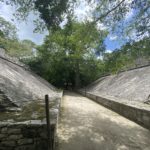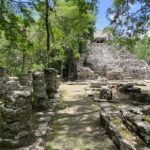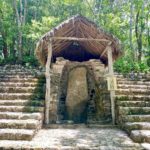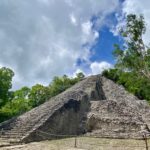Important ancient Maya city in an area of lakes, from here the great sacbe’ob (long roads) were built, which helped it survive over many others until it was defeated by Chichen Itza. The round observatory, the great Pyramid of Nohoch Mul and the stunning inscriptions make it unique.
The city of Cobá covers an area of around 70km, and the principal groups of buildings are situated near the lakes of Coba and Macanxoc. It has an important network of white roads, known in Maya as sacbe’ob, of varying lengths, which connect it with other building groups and prehispanic settlements. The most notable example is Sacbé 1, which is 100km. long and reaches the site of Yaxuná, near Chichén Itzá. The major roads or causeways were built between 600 and 800 AD. During this same period of time, the stelae of Cobá were erected. These were sculptured stone monuments on which the basic events of the ruling class were registered. The inhabitants, who did not belong to this social class, lived on the outskirts of the central zone and their dwellings did not differ much from the ones inhabited by present day Mayans. It is estimated that the population of Cobá in the 8th century was approximately 55,000 inhabitants. Between 800 and 1100 AD, construction development reached its peak. The classical architectural style of Cobá resembles more that of the Petén of Guatemala than that of the northern Yucatán. By the time of the Post-Classic period, Cobá lost its superior force and other cities from along the coast, such as Tulum, Xcaret, Tankah and El Rey, began to flourish.
 Lying between Cobá and Macanxoc lakes, this is the largest concentration of buildings in all of Cobá. It comprises 43 structures, various courtyards, vaulted rooms, a grand plaza, a Ball Court and several stelae. Six sacbe’ob branch out from this group. The building known as the Church (Iglesia) is formed by nine, round-cornered bodies, which reaches a height of 24 meters. It has various construction stages, each built upon the preceding one. Construction began in the Early Classic period (300-600 A.D.) and the last modification was made during the Post-Classic period (1000-1450 A.D.). At the foot of the Church stands Stele 11 with a circular altar.
Lying between Cobá and Macanxoc lakes, this is the largest concentration of buildings in all of Cobá. It comprises 43 structures, various courtyards, vaulted rooms, a grand plaza, a Ball Court and several stelae. Six sacbe’ob branch out from this group. The building known as the Church (Iglesia) is formed by nine, round-cornered bodies, which reaches a height of 24 meters. It has various construction stages, each built upon the preceding one. Construction began in the Early Classic period (300-600 A.D.) and the last modification was made during the Post-Classic period (1000-1450 A.D.). At the foot of the Church stands Stele 11 with a circular altar. This group of buildings mostly corresponds to the last period of occupation in Cobá. Building I has a temple on its upper part whose frieze and lintel were richly painted on their interior side, as well as with a stele. Structure III probably had a roof made out of perishable materials and in front of it are 13 small altars, suggesting the ritual character of the complex. Two other stelae, 26 and 28 are found in their respective sanctuaries at the extremes of the complex. This group of buildings belongs to the last period of occupation of the city of Cobá. Its architectural style pertains to what is called the east coast style, which corresponds to the Post-Classic period (1100-1450 A.D.).
This group of buildings mostly corresponds to the last period of occupation in Cobá. Building I has a temple on its upper part whose frieze and lintel were richly painted on their interior side, as well as with a stele. Structure III probably had a roof made out of perishable materials and in front of it are 13 small altars, suggesting the ritual character of the complex. Two other stelae, 26 and 28 are found in their respective sanctuaries at the extremes of the complex. This group of buildings belongs to the last period of occupation of the city of Cobá. Its architectural style pertains to what is called the east coast style, which corresponds to the Post-Classic period (1100-1450 A.D.). One reaches this Group by taking Sakbe 9, which is 20m wide and leads directly to Stele 21. This stele is sculpted on all four sides and has 313 hieroglyphs. The Group was built upon a large terrace and its buildings, unlike others in Coba, lack a careful distribution. There are eight sculpted stelae and numerous other monolithic altars unassociated with them. The large concentration of stelae concertated here suggests that the Group had a very important civic-ceremonial use.
One reaches this Group by taking Sakbe 9, which is 20m wide and leads directly to Stele 21. This stele is sculpted on all four sides and has 313 hieroglyphs. The Group was built upon a large terrace and its buildings, unlike others in Coba, lack a careful distribution. There are eight sculpted stelae and numerous other monolithic altars unassociated with them. The large concentration of stelae concertated here suggests that the Group had a very important civic-ceremonial use. IT is a nicely restored, conical shaped structure 14 meters high and four levels that are believed to represent the seasons of the year. IT also has a staircase with 20 steps in its central part that are believed to represent the days of the month in the Mayan calendar. A number of sacbeob enter into and leave from here. The main structure is known as Xai’be, “crossroads” in Yucatec Maya.
IT is a nicely restored, conical shaped structure 14 meters high and four levels that are believed to represent the seasons of the year. IT also has a staircase with 20 steps in its central part that are believed to represent the days of the month in the Mayan calendar. A number of sacbeob enter into and leave from here. The main structure is known as Xai’be, “crossroads” in Yucatec Maya. This Group covers an area of 2,400 sq. mts. and was built atop a natural elevation. It boasts the tallest structure in northern Yucatán, 42m. This building, known as Nohoch-Mul, coming from the Maya nohoch meaning big, and mul meaning mound, is comprised of seven bodies with rounded corners and two stair-ways on the southern side. The upper temple corresponds to the Post-Classic period (1100-1450 A.D.) and in the niches of the façade one can observe a descending god. The Grand Platform which is the most voluminous structure in Cobá, is apparently an unfinished structure. In front of Building X, stands Stele 30, the best preserved of all those found in Cobá to date, which is inscribed with the date November 30, 780 A.D.
This Group covers an area of 2,400 sq. mts. and was built atop a natural elevation. It boasts the tallest structure in northern Yucatán, 42m. This building, known as Nohoch-Mul, coming from the Maya nohoch meaning big, and mul meaning mound, is comprised of seven bodies with rounded corners and two stair-ways on the southern side. The upper temple corresponds to the Post-Classic period (1100-1450 A.D.) and in the niches of the façade one can observe a descending god. The Grand Platform which is the most voluminous structure in Cobá, is apparently an unfinished structure. In front of Building X, stands Stele 30, the best preserved of all those found in Cobá to date, which is inscribed with the date November 30, 780 A.D.
- HMdb: The Coba Group
- HMdb:Paintings Complex
- Grupo Macanxoc -Sitio arqueológico Cobá
- Observatory
- HMdb: Nohoch Mul Group
Grupo Macanxoc – Lonely Planet
Grupo Macanxoc – Lugares INAH
ABOUT
SOURCES & RESOURCES
- Ancient Maya site explorers will find fertile ground in Cobá’s lengthy history
- Coba – Mayan Ruins Website
- Cobá, sitio arqueológico maya – Pueblos Originarios
- Complete travel guide to Coba
- En Yucatan: Coba Mayan Ruis
- HMdb: The City of Cobá
- How to visit Coba Ruins: the best itinerary and practical tips
- Maya Adventure: Coba
- Nohoch Mul Pyramid in Mexico and How 6 More Historical Monuments Would Look if Restored Today
- Visiting the Maya Ruins of Cobá
- WikiVoyage: Coba
VIDEO

